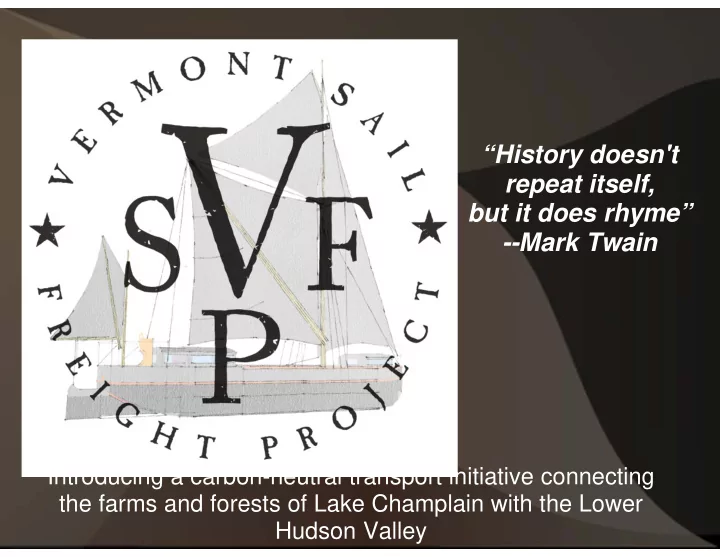

“History doesn't repeat itself, but it does rhyme” --Mark Twain Introducing a carbon-neutral transport initiative connecting the farms and forests of Lake Champlain with the Lower Hudson Valley
A collaboration between A collaboration between local farmers and the local farmers and the Willowell Foundation Willowell Foundation Our Goals: Develop and prove a modern method of cargo distribution using sail power Involve students and the community Enhance area farmers' livelihoods through access to superior markets Generate excitement and inspiration for creative energy innovation Demonstrate a constructive community-scale approach to energy descent
How can freight watercraft add to urban sustainability? • Utilize pre-existing city layout features and infrastructure (low redeployment costs) • Lowest carbon cost per ton mile • Foster civic engagement at the waterfront
What kinds of foods can we transport by sail? Grains, flours, and beans Sauces, jellies, hot sauce, preserves, pickles, saurkraut Hard cider and wine Dry beans Shelf stable fresh produce like apples and cabbages Root vegetables like potatoes, carrots, onions, garlic Coffee, sugar, chocolate
15 tons of food. 330 miles. VSFP is a new take on the Vernacular Merchant Marine Tradition! www.vermontsailfreightproject.org
The Whole Ball of Wax Brought about nearly entirely by volunteers Based on a systems-thinking approach Farming and Food System-Centered Regional in Scope Based on time-proven technologies Adaptive to contemporary economic constraints Adaptive to today's tendency to live life online Part of a worldwide rebirth of working sail Supported by grants and donations Expected to become self-sustaining within a 2 year timeframe
Trading Concept Internet pre-orders / waterside pickup Cash sales of onboard inventory while en route Wholesale to NYC resellers who can then use our delivered by sail label
Ceres LOA: 39'6” Beam: 10 1 1/2” Rig: Spritsail (can be lowered) Displacement: 38,000 lbs GRT: 14.92 Tons Classification: Cargo ship, uninspected Home Port: Vergennes, Vermont Construction Budget: $20000 Hull Material: AC fir plywood with epoxy fiberglass sheathing Crew complement: 2-3
Implications A revival of inland working sail can generate employment while moving goods around the region without fuel cost or carbon emissions Simplified designs executed with common, low-cost materials will be easily executed by a variety of communities, and adaptable to particular needs Population centers are already located on working waterways. The infrastructure for working sail already largely exists. Working sail can find ways to function economically in the world as it is while simulatneously preparing for approaching changes. Sail is an ancient, beautiful and compelling technology
Recommend
More recommend